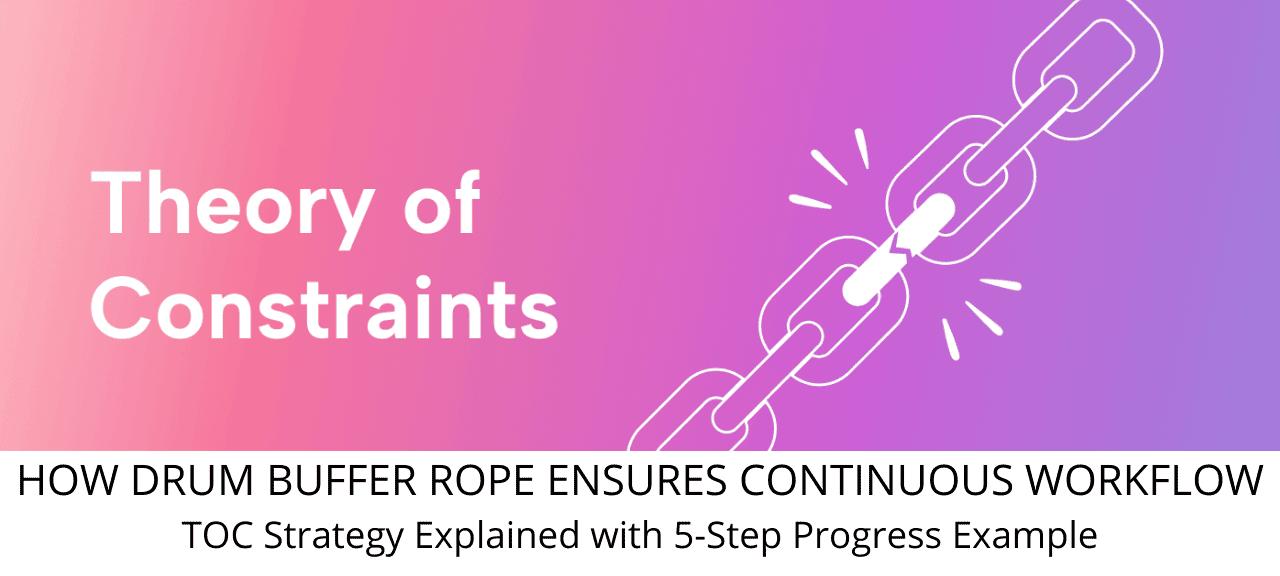In the Theory of Constraints (TOC), the Drum-Buffer-Rope (DBR) system is a powerful scheduling and control mechanism designed to ensure constant, efficient workflow by protecting and coordinating around the system’s constraint.
It addresses a core problem in many production and project environments: unbalanced workloads, delays, and overproduction. This article explains how Drum, Buffer, and Rope work together to maintain consistent progress across five stages of a process—supported with a real-life example.
What Is Drum-Buffer-Rope (DBR)?
| Element | Role in Workflow |
|---|---|
| Drum | Sets the pace—usually the system’s constraint |
| Buffer | Protects the Drum by absorbing variability or delays |
| Rope | Controls the release of work to ensure no overloading of the Drum |
The DBR system ensures that the constraint is never starved, the system is not overloaded, and workflow remains balanced and synchronized.
How Drum-Buffer-Rope Ensures Constant Work: 5-Step Progress
Let’s walk through five stages of a manufacturing or project process to see how DBR works in action.
Step 1: Identifying the Constraint (Drum)
The Drum represents the slowest or most capacity-limited part of the process—the constraint. It determines how fast the entire system can operate.
Example: In a furniture factory, the varnishing station is the slowest step—it can only process 20 chairs per hour, while all other stations can handle 30+.
Action: Make the varnishing station the Drum, and pace the entire system to its rhythm.
Step 2: Creating the Time Buffer
The Buffer is a time or material safety margin placed before the constraint to absorb variability and prevent idle time.
Example: If the carpentry and assembly stations face occasional delays, a buffer of 10 ready-to-varnish chairs is created before the varnishing station.
Result: The Drum (varnishing station) keeps working without stoppages, even if upstream processes lag temporarily.
Step 3: Controlling Input with the Rope
The Rope is a signal mechanism that controls how and when raw materials or tasks are released into the system—based on the Drum’s capacity.
Example: The factory only starts producing new chair frames once the buffer drops to 5 or fewer—ensuring no overproduction and that work-in-progress stays lean.
Result: Synchronization is maintained; the upstream teams don't produce excess that piles up unnecessarily.
Step 4: Monitoring Progress and Adjusting Buffers
Constantly monitor the buffer to detect if the system is being overloaded or starved.
Example: If the buffer before the varnishing station drops too low, it's a signal that upstream steps must speed up temporarily. If it's consistently too full, perhaps the Drum needs capacity elevation.
Benefit: This ensures a smooth, continuous flow without chaos or urgent firefighting.
Step 5: Elevating the Constraint If Necessary
If the system demand consistently exceeds the Drum's capacity, you can "elevate the constraint" by adding resources or improving efficiency.
Example: Add another varnishing unit, outsource partial work, or switch to faster-drying materials.
Result: Once the constraint is resolved, a new Drum is identified, and the DBR cycle restarts.
Real-World Example: Furniture Manufacturing
Let’s summarize a real-world furniture workflow applying DBR:
| Stage | Process | DBR Role |
|---|---|---|
| Step 1 | Varnishing | Drum (slowest step) |
| Step 2 | Buffer 10 ready chairs | Buffer |
| Step 3 | Controlled carpentry start | Rope |
| Step 4 | Adjust based on buffer changes | Monitoring & Feedback |
| Step 5 | Add varnish machine | Elevate Constraint |
The result? No overproduction, minimal idle time, and maximum throughput based on actual system limitations.
Key Benefits of Drum-Buffer-Rope
- Ensures constant work and balanced workflow
- Reduces overproduction and excess inventory
- Minimizes idle time at the constraint
- Encourages system-wide coordination
- Improves on-time delivery and throughput
The Drum-Buffer-Rope system is one of the most practical and effective tools from the Theory of Constraints. It doesn’t just improve efficiency—it creates stability, predictability, and continuous progress even in complex operations.
By applying it step-by-step across your workflow, you can maximize throughput, reduce chaos, and ensure your constraint is never a liability—but a guiding drumbeat for the entire system.
drum buffer rope example, theory of constraints production flow, how DBR ensures constant work, buffer management TOC, constraint-based scheduling, TOC manufacturing workflow, drum buffer rope 5 step process

